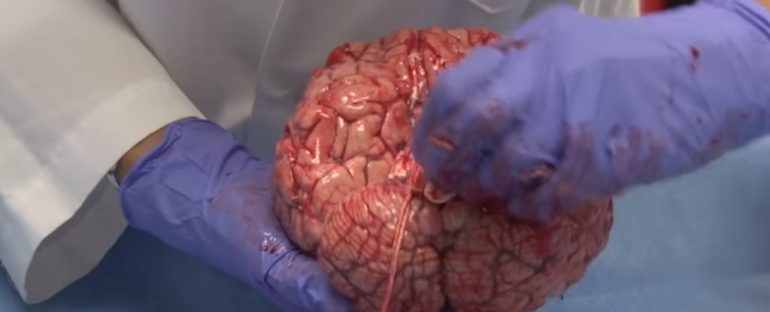Even though you use your brain to do a lot of thinking, you probably don’t think about your brain that often.
It’s an incredibly complex, incredibly precious organ. It’s also incredibly squishy, as you can see in an amazing teaching video that demonstrates a freshly removed brain straight from autopsy.
As the neuroanatomist handles the vulnerable blob with the utmost care, it’s awe-inspiring to realise that each one of us has a squishy brain just like it – and it contains all our memories and thoughts.
The video, published on YouTube by the University of Utah Neuroscience Initiative back in 2013, is aimed at students who don’t have access to ‘fresh’ brains such as this one, and have only preserved brains, models, and pictures as study aids.
“Students tend to think that the brain is sort-of the consistency of a rubber ball, and that’s because in the laboratories, and teaching specimens, we have formalin-fixed brains,” says neuroanatomist Suzanne Stensaas in the video.
“However, if you’re a trauma surgeon or a neurosurgeon, you realise that the brain is really very, very soft, and much more vulnerable than the impression you get when you’re looking at the fixed brain.”
As she’s holding the 1.4 kg (3 lbs) brain in both palms, it’s absolutely wild to realise that right there is the entire set of life experiences of what was once a living, feeling human being.
“We are fortunate enough to show you what a normal, unfixed, recently deceased patient’s brain would look like,” says Stensaas.
As she explains, the cancer patient whose autopsy this brain is from, died from cell transplant complications. And seeing how Stensaas handles the specimen, we feel honoured to be able to learn so much thanks to the patient who donated their body to science.
Our brains are usually protected by several membranes, cushioned by the cerebrospinal fluid and further encased within the hardy casing of the skull, so seeing it out in the open like that is a jarring reminder of how precious our brains really are.
And that’s actually one of the purposes of the video – apart from being a teaching material, the university wanted “to stress the vulnerability of the brain to highlight the importance of wearing helmets, seat belts, and taking care of this very precious tissue.”
Indeed, after seeing this, it’s difficult to put into words just how fragile the brain really is.
“It’s much softer than most of the meat you would see in the market,” Stensaas puts it in perspective as she’s gently rotating the organ to show off the hemispheres and the wrinkly cerebellum.
Even though she continues to rotate it, presumably to avoid holding it in one place for too long, she manages to leave a slight indentation of her finger on top of one of the hemispheres.
And it turns out that even when a brain is preserved in a fixation solution, it can’t be left sitting at the bottom of the tank as that will make it squat and out of shape – hence scientists loop a cord through one of the arteries to suspend the brain in the liquid (who knew!).
You can also see what looks like a piece of fabric stuck between the two hemispheres – that is actually the dura mater, the outermost of the three membranes that protect the brain.
As Stensaas is pointing out the various anatomical features, we also get a clear glimpse of the brainstem, which looks shockingly thin, considering how many of our vital nerve impulses travel back and forth through that tiny bundle of nerves.
Just incredible.
We’ve embedded the whole video below, and at this stage, it’s probably pointless to warn you again that it is indeed quite graphic (but also amazing at the same time, so we do encourage you to watch it).
A version of this article was first published in October 2017.



